
Showing 901 - 920 of 1247 results
50 Year Anniversary of Moon Landing
On 20 July 1969, humans landed on the moon for the very first time. As Neil Armstrong was lowered onto the surface of the moon he made the now infamous statement, “That's one small step for man, one giant leap for mankind”.
Black carbon detection technology launched commercially
The Multi-wavelength absorption black carbon instrument (MABI), a technology designed and built at ANSTO to measure black carbon in the atmosphere is now commercially available from Thomson Environmental Systems.
Congratulations to scholarship winner
Close look at a machine that will make high-precision parts in the future
Scientists untangle the challenging complexities of radiocarbon in ice cores
Research elucidates how in situ cosmogenic radiocarbon is produced, retained and lost in the top layer of compacting snow (the ‘firn layer’) and the shallow ice below at an ice accumulation site in Greenland.
Understanding pollutants impact
Research highlights how biodistribution of a toxic substance essential to understand all exposure risks.
Infrastructure - Planetary Materials
At ANSTO we have a large range of facilities that can be used to investigate planetary materials.
ANSTO contributes to new research could pave the way for safer and more efficient COVID-19 testing
International research led by Monash University and the Peter Doherty Institute for Infection and Immunity has achieved a proof of concept for a new, fast, portable saliva screening test that uses an infrared light technology to confirm infection with SARS-CoV-2.

Our impact
Recent news, highlights, and impact case studies from CAS’ research and industry user communities and collaborations/partners
Join ANSTO for a sensational week of science fun online
Brothers produce excellent scientific results with improvements to silicon
Collaboration develops innovative cancer diagnostic agent
New facility complements ANSTO’s extensive radiocarbon capabilities
A new radiocarbon dating facility opened at the University of New South Wales (UNSW) will complement the extensive radiocarbon facilities at ANSTO’s world-leading Centre for Accelerator Science
Building knowledge of changes in uranium chemistry
A new systematic investigation of the origins of atomic structural distortions in compounds containing uranium has relevance for spent nuclear fuel .
International collaboration on advanced manufacturing
Highly accurate non-invasive nuclear technique helps validate theoretical model for optimised laser material deposition in additive manufacturing.

Research to improve food quality and design for better health
We are using nuclear and other methods to improve the traceability of food to ensure safety and security for consumers and industry, optimise the various functions of food and its production and understand the fundamental mechanisms that link some food to an immune response
Neutron Science Workshop with University of Tokyo
Feathery moa’s fossilised footprints, ancient age revealed
ANSTO scientist, Dr Klaus Wilcken of the Centre for Accelerator Science, used cosmogenic nuclide dating to determine the ages of layered sand and gravel samples, in which seven footprints of the flightless bird, the moa, were found on the South Island in New Zealand in 2019.
Celebrating NAIDOC week
ANSTO proudly contributes to measures that recognise all aspects of Aboriginal and Torres Strait Islander culture and heritage during NAIDOC Week and all year.